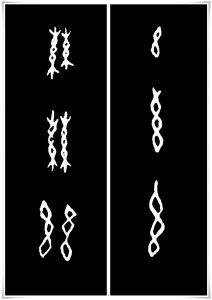
1. Meaning:
thread
2. Readings:
- Kunyomi (訓読み): いと
- Onyomi (音読み): シ
- Japanese names: does not appear in Japanese names.
- Chinese reading: mì
3. Etymology
糸 belongs to the category of characters known as 会意文字 (かいいもじ, kaii moji, i.e. a set of characters which are a combination of two or more pictographs, or characters whose meaning is based upon an abstract concept).
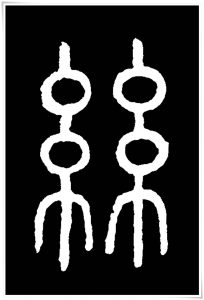
To understand the reasoning behind this classification one needs to look at the old form of the character 糸, which is 絲. 絲 is a combination of two pictographs, two threads forming a simple sheaf. In this capacity, 糸 is not a character of pictographic origin, as many sources erroneously suggest, but a ryakuji (略字, りゃくじ, i.e. “character of fewer stroke counts”) of the more complex character 絲.
In “Explaining Simple (Characters) and Analyzing Compound Characters” (說文解字, pinyin: Shūowén Jiězì) from the 2nd century C.E., compiled by Xu Shen (許慎, pinyin: Xǔ Shèn, ca. 58 C.E. – ca. 147 C.E.), a philologist of the Han dynasty (漢朝, pinyin: Hàn Cháo , 206 B.C. – 220 C.E.), we read: 蠶所吐也 (pinyin: Cán suǒ tǔ yě), which means that 糸 is raw silk thread produced by a silkworm.
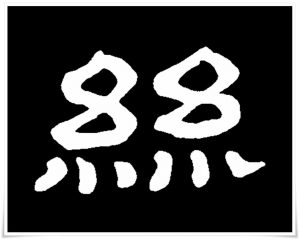
There is an ancient legend that originated during the time of the Three Sovereigns and Five Emperors (三皇五帝; pinyin: Sānhuáng wǔdì, circa 2500 B.C. to 2100 B.C.), the mythical rulers of China, which preceded the first historically confirmed dynasty of China, the Xia dynasty (夏朝; pinyin: Xià Cháo, 2070 B.C. – ca. 1600 B.C.). It says that the first wife of the Yellow Emperor (黄帝, pinyin: Huángdì, 2697 B.C. – 2597 B.C. or 2696 B.C. – 2598 BC.) (out of four wives), Empress Lei Zu (嫘祖, pinyin: Léi Zǔ), was the first to raise silkworms in order to create silk thread and made silk garments from it. In Chinese 累 means “to bind together (in here: silk threads)” and 女 means “a woman”, thus her first name, Lei, means “a woman who weaves silk thread”. She is also known as Xian Can (先蠶, pinyin: Xiān Cán, lit. “First Silkworm”). It is said that she wove the robes using silk threads created by the worshiped God of Silkworms (蚕示). This legend laid the foundation for silk culture.
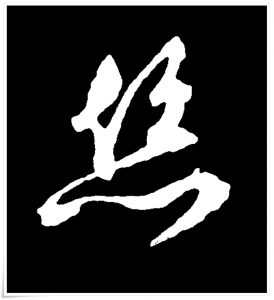
4. Selected historical forms of 糸 (絲).
Figure 1. Oracle bone script (甲骨文, こうこつぶん, kōkotsubun), form of 絲 (left) and 糸 (right), ca.1600 B.C.
Figure 2. Small seal script (小篆, しょうてん, shōten) form of the character 絲 found in the book entitled “Explaining Simple (Characters) and Analyzing Compound Characters” (說文解字, pinyin: Shūowén Jiězì) from the 2nd century C.E., compiled by Xu Shen (許慎, pinyin: Xǔ Shèn, ca. 58 C.E. – ca. 147 C.E.), a philologist of the Han dynasty (漢朝, pinyin: Hàn Cháo , 206 B.C. – 220 C.E.).
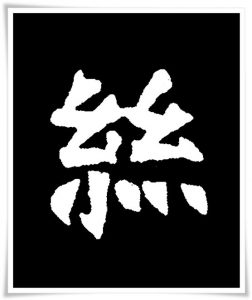
Figure 3. Ink rubbing of the clerical script form (隷書, れいしょ, reisho) of the character 絲, taken from the late Han dynasty (後漢; 東漢, pinyin: Dōng Hàn, 25 – 220 C.E.) stele Heng fang bei (衡方碑, pinyin: Héng f ā ng bēi), 168 C.E.
Figure 4. A cursive script (草書, そうしょ, sōsho) form of the character 絲, from the ink rubbing from the work of Wen Zhengming (文徴明, pinyin: Wén Zēngmíng, 1470-1559) of the Ming dynasty (明朝, pinyin: Míng Cháo, 1368 – 1644).
Figure 5. Ink rubbing of powerful standard script (楷書, かいしょ, kaisho) of the character 絲, found in the compilation of poems inscribed on the tomb of the Yuan Qin royal family (元欽, pinyin: Yuán Qīn, reing period 470 – 528 C.E.), Northern Wei dynasty (北魏, pinyin: Bĕi Wèi, 386 – 534).

Figure 6. Semi-cursive script form of the character 絲 found in calligraphy by Chen Ji (陳基, pinyin: Chén Jī, 1314-1370), a high ranking politician of the Yuan dynasty (元朝; pinyin: Yuán Cháo, 1271{4} – 1368).
5. Useful phrases
- 生糸 (きいと, ki-ito) – raw silk (thread)
- 糸雨 (しう shiu) – misty rain, drizzle
- 糸巻き (いとまき, itomaki) – spool
- 綿糸 (めんし, menshi) – cotton yarn (thread)
- 絹糸 (けんし, kenshi) – silk thread
